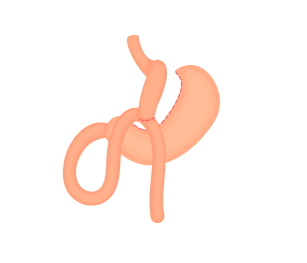
Bariatric surgery is a surgical procedure performed to support weight loss of patients with extreme obesity (morbid obesity). Bariatric surgery works with anatomical changes in the stomach and intestines of patients.
These procedures help patients eat less by increasing the feeling of fullness and therefore lose weight. Also, the effect of the procedures on the intestines reduces the absorption of food, increasing weight loss.
Bariatric surgery is usually performed when other weight loss methods such as diet and exercise are ineffective or do not provide sufficient results. In addition, bariatric surgery can help in the management of obesity-related health problems (diabetes, hypertension, sleep apnea, heart disease, etc.).
What are the types of obesity surgery?
Types of obesity surgery can be listed as follows:
Gastric Balloon: A silicone balloon is placed in the stomach so that the patient can eat less food. This procedure is a temporary solution and the balloon is usually removed within 6-12 months.
Gastric Bypass: In this procedure, the stomach is shrunk and a small portion of the stomach is connected directly to the small intestine. This promotes weight loss by reducing both stomach capacity and the absorption of food in the intestines.
Sleeve Gastrectomy: In this procedure, the stomach is reduced by approximately 80% and then its connection with the small intestines is left. This procedure also supports weight loss by reducing both the stomach capacity and the absorption of food in the intestines.
Laparoscopic Adjustable Gastric Band: In this procedure, a band is placed on the stomach so that the patient can eat less. This procedure, like other procedures, supports weight loss by reducing stomach capacity.
Biliopancreatic Diverter (BPD): In this procedure, various anatomical changes are made to shrink the stomach and reduce the absorption of food in the intestines. This procedure is a less common procedure and is performed only in patients with extreme obesity.
Factors such as the patient’s lifestyle, medical condition, and body mass index are considered to determine which of these procedures is most appropriate.
Who can have a gastric balloon?
The gastric balloon can be applied to adult patients who are overweight or on the verge of obesity and have failed other weight loss methods (diet and exercise). It may also be an option for patients with obesity-related health problems.
Gastric balloon application can be recommended as an alternative to more invasive methods, especially gastric reduction surgery. However, gastric balloon application may not be as permanent a solution as other bariatric surgery procedures such as gastric bypass or sleeve gastrectomy.
However, it may not be suitable for every patient. Gastric balloon is not applied to pregnant women, people with gastric or esophageal ulcers, gastric emptying problems, previous gastric surgery and certain other medical conditions. Therefore, it is necessary to consult with a doctor first to decide whether a patient’s gastric balloon application is appropriate.
Who is gastritis bypass applied to?
Gastric bypass can be applied to adult patients who are overweight or on the verge of obesity and have failed other weight loss methods (diet and exercise). This procedure is suitable for patients with a body mass index (BMI) of 40 or above or a BMI of 35-39.9, those with obesity-related health problems (for example, diabetes, hypertension, sleep apnea, heart disease, etc.) or those with factors that increase the risk of these diseases ( for example, high blood pressure, high cholesterol levels, family history, etc.).
Gastric bypass, also known as gastric reduction surgery, is designed to reduce stomach volume and reduce the absorption of food through the digestive tract. This procedure is one of the most widely used weight loss methods and is used to control or alleviate obesity-related health problems. However, it may not be suitable for every patient and each patient may be in a different situation. Therefore, it is important to consult with a physician to decide whether a patient’s gastric bypass procedure is appropriate.
What is sleeve gastrectomy operation?
Gastric sleeve surgery is a surgical procedure to treat obesity. It is designed to shrink the stomach and may be an option for patients who are overweight or borderline obese.
During sleeve gastrectomy, the stomach is greatly reduced and reshaped into a tube. This leads to a reduction in stomach volume and therefore less food consumption. Another name for this procedure is sleeve gastrectomy.
Gastric sleeve surgery is used to control or alleviate obesity-related health problems. It can also be applied when other weight loss methods (diet and exercise) fail or do not produce sufficient results.
Gastric sleeve surgery may be a less invasive option compared to more invasive bariatric surgery procedures such as gastric bypass. However, it may not be suitable for every patient and each patient may be in a different situation. Therefore, it is important to consult with a doctor to decide whether a patient’s sleeve gastrectomy is appropriate.
What is stomach botox?
Stomach botox is a medical procedure to relax the stomach muscles and reduce stomach acid secretion. This procedure can be used to treat certain digestive system conditions, such as gastroesophageal reflux disease (GERD).
During the stomach botox procedure, botulinum toxin is injected into the stomach. Botulinum toxin blocks the nerves from sending signals to the muscles, which causes the muscles to relax and decrease muscle activity. Stomach muscles are also affected by this process and stomach movements slow down. Thus, acid secretion in the stomach decreases and symptoms related to digestive system problems such as gastroesophageal reflux disease decrease.
Stomach botox may be beneficial for some patients. However, it may not be suitable for every patient and each patient may be in a different situation. Therefore, it is important to consult with a doctor to decide whether a patient’s stomach botox procedure is appropriate.

Tubular Stomach Surgery

Gastric Bypass Surgery

Duodenal Switch

Metabolic Surgery




